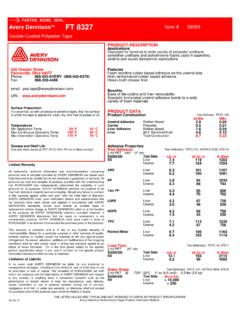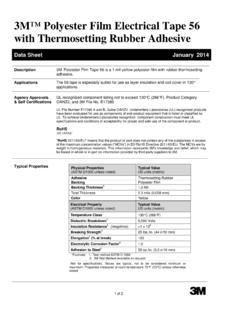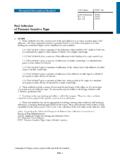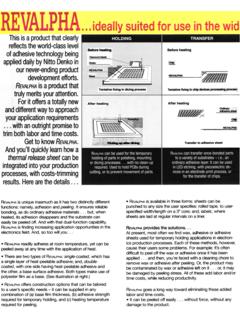Transcription of ARSC CONFERENCE PAPER RICHARD L HESS Tape …
1 A R S C C O N F E R E N C E PA P E R | RICHARD L. HESS. tape Degradation Factors and Challenges in Predicting tape Life From about 1950 through the 1990s, most of the world's sound was entrusted to analog magnetic recording tape for archival storage. Now that analog magnetic tape has moved into a niche market, audio professionals and archivists worry about the remaining life- time of existing tapes. This article, based on the author's presentation at the 2007 ARSC. CONFERENCE at the Ward Irish Music Archive, Milwaukee, WI, defines the basic tape types and the current state of knowledge of their degradation mechanisms. Conflicting prior work is reviewed and correlated with current experience. A new playback method for squealing tapes is described.
2 The challenges in predicting future tape life is discussed. Illustrations of various types of tape degradations and a survey of many of the techniques used for tape restoration are included. Suggestions are made for further research and archival practices. _____. F rom its introduction in Germany in 1935 and its worldwide rise to the primary medium for audio recording in the late 1940s and 1950s, magnetic tape earned a deserved reputa- tion as a reliable and high-quality storage There are vast archives of magnetic tape that contain information that needs to be preserved. As Dietrich Schuller2 so aptly stated, The world's stock of audio recordings is estimated to be more than 50 Mh (mil- lion hours) of materials.
3 None of these recordings are on permanent carriers The following claim was found in promotional material for a Workshop: Audiovisual Preservation for Culture, Heritage and Academic Collection on the Digitization 101. Blog. Seventy percent of all audiovisual material is under immediate threat of deterioration, damage or obsolescence and seventy percent of collection managers don't know it. Surveys have found serious shortages of trained staff and equipment, and an even more serious shortage of concerted preservation actions. The immediate needs are: awareness . and The present author became more widely involved with audio preservation and restoration in 2001 while transferring 51 reels of the oldest tapes in the This work became a full-time career in 2004, and the need for further research into the degradation modalities of magnetic tape became obvious.
4 This PAPER provides a review of tape types and their degradations and addresses what is known, what is hypothesized, and where more research is required. ARSC Journal XXXIV / ii 2008. Association for Recorded Sound Collections 2008. All rights reserved. Printed in USA. tape Degradation Factors and 241. Challenges in Predicting tape Life Brief Chronology of tape Types 1932 Magnetic tape development underway at Ludwigshafen, Germany5. 1935 Magnetophonband Typ C coated acetate tape 1944 Magnetophonband Typ L homogeneous PVC tape 1950s Back coating introduced in Europe 1953 First PET tape from 3M. 1960s Back coating becomes widespread 1972 BASF ceases production of PVC tape 1972/73 3M/Scotch ceases production of acetate tape Current status The use of analog tape declined rapidly at the end of the 20th century, with the major tape manufacturers consolidating and/or spinning off their tape operations and most of them ultimately closing or substantially restructuring.
5 Manufacture of high-end analog audio tape recorders has virtually Many musicians and recording engineers prefer the sound of analog for recording, so new material is still being generated, complicating archival strategies. Conceptual timeline Many factors influence the overall quality of a digital copy of an original analog tape , including (1) the condition of the original tape based on inherent and external degrada- tion factors, (2) the original quality and state of maintenance of the tape reproducer (considering few if any additional quality reproducers will be manufactured), and (3) the quality of the digitization. The overall transfer quality is the product of all of these fac- tors, as conceptually shown in Figure 1.
6 Figure 1. Conceptual timeline: Many factors influence the overall quality of a digital copy of an original analog tape . Source: the author. _____. 242 ARSC Journal While the exact shapes of the curves vary with each tape format and type, the fac- tors remain the same. The Reproducer Quality curve includes the availability of techni- cians skilled in the ability to maximize playback quality as well as to recognize and to treat problems as they are encountered. Since the publication of the original AES preprint of this PAPER in 2006-10, there has been discussion as to whether this graph is optimistic or pessimistic. There are, of course, many variables involved, but it should be possible to maintain certain models of at least reel-to-reel players or perhaps even construct new ones at least through 2035 and perhaps further into the future.
7 This timeline and comments made under acetate tape are not meant to reduce the pressure to digitize now. Rather, it is meant to show that the time is short considering the amount of digitization that needs to be done. Current best practice is to digitize tapes sooner rather than later and to store these digi- tal files in managed repositories and distribute copies to minimize the effects of cata- strophic loss of a single archives. This distributed concept is formalized under the acronym LOCKSS Lots Of Copies Keep Stuff Safe. tape Formulations In analyzing tapes for aging properties, it is useful to look at the three major compo- nents that vary between tapes (Figure 2). The work is presented in the following order because the base film, although in the middle, is the foundation of the tape .
8 Base film Binder/oxide coating (includes lubrication). Back coating (not on all tapes). Figure 2. tape Formulations: In analyzing tapes for aging properties, it is useful to look at the major com- ponents that vary between tapes. Source: the author. _____. Base film The base film provides structural integrity to the tape . The following base films have been used over time for analog audio tapes:7, 8, 9, 10. Acetate (1935-1972/73). PVC (1944-1972) [Polyvinyl chloride], also known as Luvitherm PAPER ( )11. PET (1953-present) [Polyethylene terephthalate] also known as Mylar, Polyester, Tenzar tape Degradation Factors and 243. Challenges in Predicting tape Life Binder/oxide coating The oxide consists of a mix of magnetic particles that retain the magnetism impressed on them by the recording head.
9 The binder is the glue or matrix that holds the oxide parti- cles to the base film. A lubricant is added to the binder/oxide mix to reduce friction and In the case of analog audio tapes where little or no air film (or bearing) is developed during normal operation, the solid or liquid lubricant embedded in the tape is the only source of friction reduction in the tape -to-head and tape -to-stationary-guide interfaces. Multiple binder/oxide formulations have been utilized. The major focus has been on the magnetic performance of the oxide with special regard to increasing the overall dynam- ic range of the tape . In order to achieve this wide dynamic range, other portions of the binder/oxide/lubricant component were modified to allow a larger percentage of magnetic particle fill.
10 Sometimes these new formulations created both short-term and long-term degradation modalities as evidenced by newer tapes aging more rapidly than older tapes. On the AES Historical Committee website,13 the listing of all 3M Audio Open Reel Tapes indicates that 11 different types of binders were used between 1947 and 1980, although this list presents some unanswered Lists providing manufacturer type designations, years produced, and summary tech- nical information are useful tools. These lists do not report the subtle changes that occurred over time in at least some of the tapes. Running changes were made in tapes without ever being indicated as a revision to the type designation. These running changes came about for many reasons, including the unavailability of a component.





